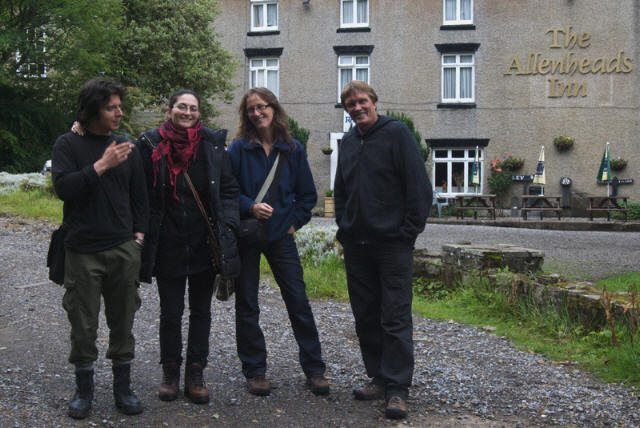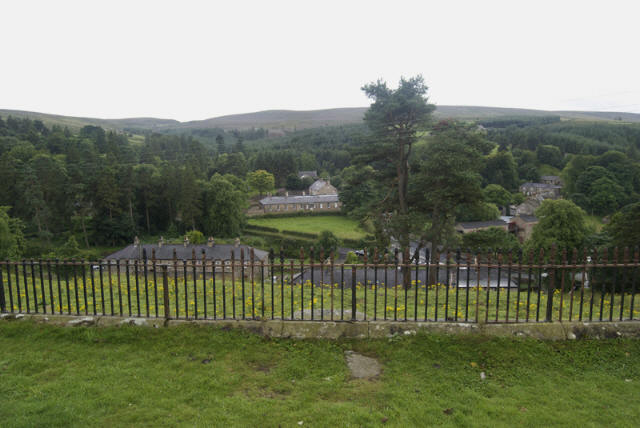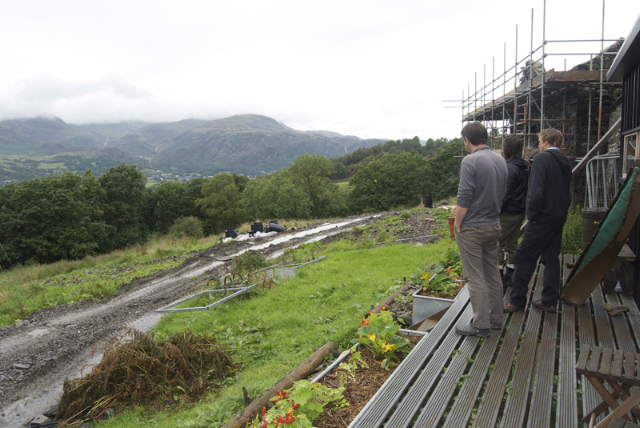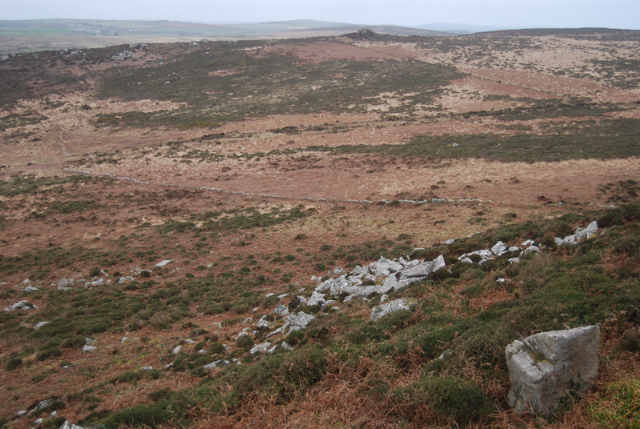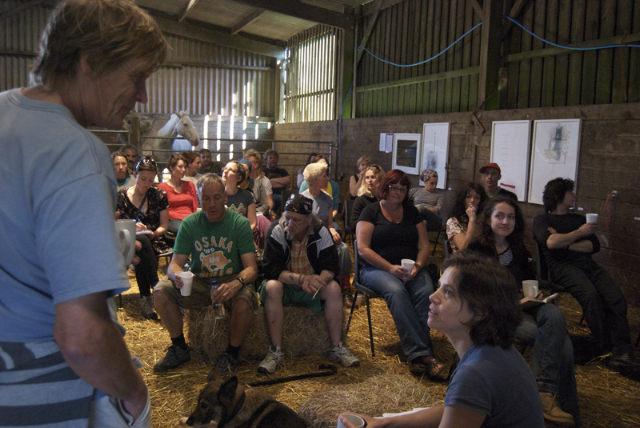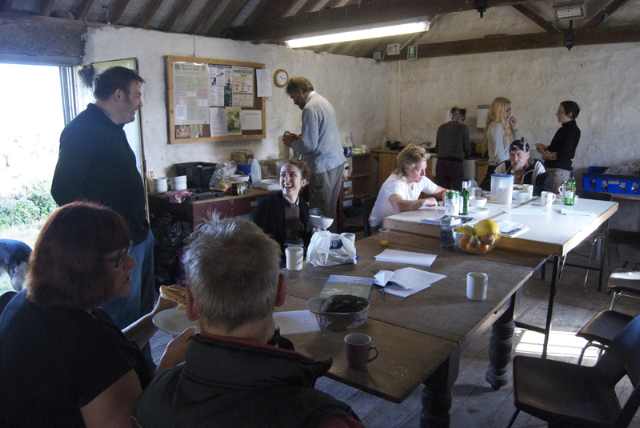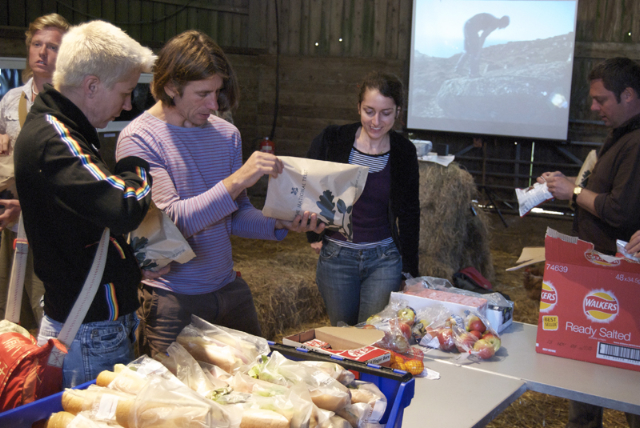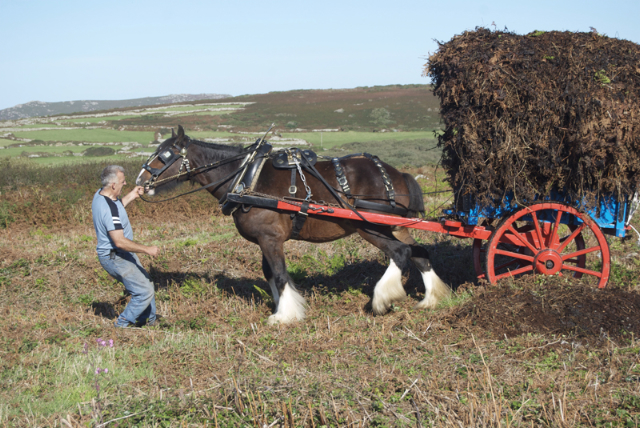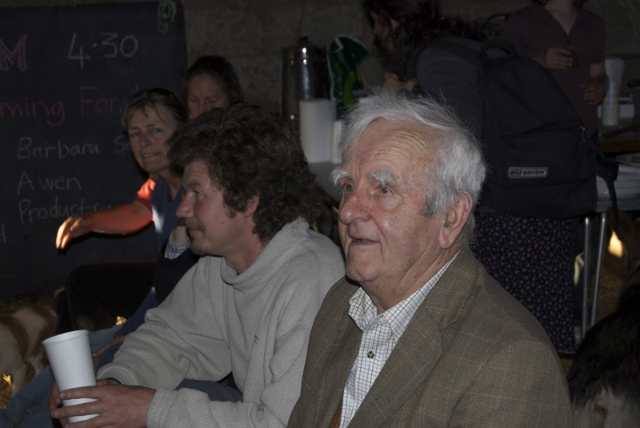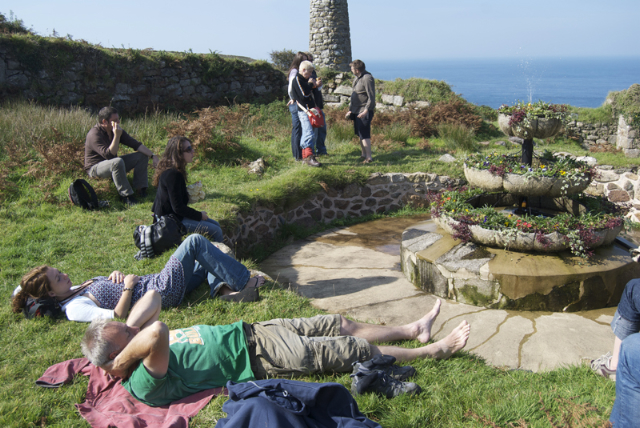|
|
| home | features | exhibitions | interviews | profiles | webprojects | gazetteer | links | archive | forum |
|
Contextually sited contemporary practice in rural areas Veronica Vickery reflects on the nature of arts practice in rural areas in the light of the events, performances, installations and seminar that made up BOS-08 and a research trip to Grizedale and Allenheads Arts in August 08.
‘Rural Arts’: the debate Over the last few years a debate has started to emerge over contemporary arts practice in rural areas, particularly as contemporary practice has become increasingly decentred. Much of it has stemmed from a sense of ‘prolonged frustration’ that the experience of artists ‘living outside of a major city was simply not represented in the mainstream of art production, discussion and exhibition’.[1]
BOSarts goes up north: from left artists Ian Whitford, Rebecca Weeks, myself & Jon Brookes (NT)
This debate challenges perceived notions of the rustic, the back and beyond, and the picturesque whilst laying claim to a practice that is cutting edge and critically engaged. The backdrop to this debate is made up of long standing initiatives in remote rural areas including Grizedale in Cumbria and Allenheads in Northumberland, and supported by research-led practice at institutions such as 'On the Edge Research' at Grays School of Art (University of Aberdeen). Allenheads Contemporary Arts is a project run by artist couple Alan Smith and Helen Ratcliffe, centered in an old Victorian Schoolhouse situated on a steep hill overlooking the village of Allenheads in Northumberland.
Looking down on the village from the old schoolhouse at Allenheads
The project has been in existence for about 15 years and is well embedded within the life of the village, which has a population of 400. The ‘kitchen table’ (a big square one that must be able to seat 16 comfortably) seems to epitomize the heart of the project, delivering an amazing welcome to long-time travelers arriving late into the evening from West Cornwall, as we did. Key features to the production of work at Allenheads seem to be: dialogue with artists and local residents and building long-term relationships; a playful engagement with contemporary concerns and work that is multi-layered with multiple points of entry. Whilst there we were shown work that ranged from a Wacky Races style go-cart race down the hill to the village, to Marcus Coates’ Dawn Chorus. Grizedale has been in existence for about 20 years but changed direction when Adam Sutherland took over as Director in 1999. Physically it is located several miles into the forest above Coniston Water, at Lawson Park an old farm that is currently the subject of a complete renovation. It is surrounded by 15 acres of its own land, which is an integral part of the project, being used for vegetable production and experimental land use.
Looking towards Coniston Water with Adam Sutherland from Lawson Park, Grizedale Forest
Recent projects have included an exchange with a village in Japan, Seven Samurai, which included horticultural skill and knowledge swapping, with part of the site being terraced by the Japanese villagers. The Grizedale philosophy is very much about finding a way for artists to be useful within the context within which they are developing projects: ‘Grizedale Arts runs a programme of events, projects, residencies and activity which seeks to develop the contemporary arts in new directions, away from the romantic and modern assumptions of culture, and to make artists more useful in this complex and multiple-cultural environment.’[2] The more I thought about the idea of writing around the subject of rural arts, the more I realized I felt uncomfortable with it. Yes, West Cornwall is a rural area and I live and work there on the edge of a small village a mile from the rugged north coast. But to define an artistic practice by its rurality - by the rural in opposition to the urban - that feels problematic.
From Carn Galva across the moor to Bosprennis and Zennor, West Cornwall
It is indisputable that these practices are all sited in areas that would first and foremost be described as rural. However as we have seen, each project has a different relationship to its geographical locality and therefore resists easy classification as being defined by its rurality. The picture is far more complex than the polarities of rural and urban allow. The lure of the rural, the wish to define a contemporary practice by picture postcard location, arises from ‘the nostalgic impulse’[3], coming out of a sense of rootlessness that characterizes life in a multi-centered society as described by Lucy Lippard.[4] It is also a short trip towards the traps of dualism and the production of difference. This latter is a particular issue in a rural area where culture is objectified as tourist product and homes built for use by people living and working the land become rural idylls for those seeking second home retreats: many people living in the far reaches of West Cornwall feel like they are living in a museum piece. Capitalism as noted by Miwon Kwon and others is dependent on the objectification and production of difference for its ongoing existence, and nowhere is that more clearly seen in remote and picturesque rural areas, where there is a perception held in the urban imagination that it is still possible to find all that was good about yester years, including that much vaunted sense of ‘community’.
BOShomes (Estate Agency) Veronica Vickery 2008
Much practice in rural areas confronts such socio-political issues head on, whether by creating an alternative economy and skill exchange such as My Villages Hofer Goods and the Grizedale Honesty Box Project, or indeed some of the work included in BOS-08. The picturesque landscape of Cumbria is often cited as the primary feature of the region; however it is the sociological circumstances and attitudes to the landscape, which distinguish it. Of particular importance is the way in which numerous ideologies are projected onto this countryside and this has produced a multiplicity of micro cultures, which compete for a stake in the land. Furthermore, as a manifestation of the wider trend towards globalization, there has been a rapid increase in pressure on the land and the way it is used. As such, the Lake District represents a microcosm of the wider world and presents itself as an ideal laboratory situation to test out new approaches to culture.[5] What could be said to define these practices is their deep engagement with socio-political context rather than the rural in opposition to the urban. They are very much contextually sited contemporary practice.
What is distinctive about practice in a rural area? The more I have thought about it, the more I have come to an understanding that what marks these projects out is not so much rurality and location, but the way in which they approach practice. Something interesting is happening. Indeed perhaps the peripherality of their location ensures that unless they have a critically engaged practice they will not attract an audience, or get noticed, unlike the preponderance of urban-based projects who are more or less guaranteed an audience by sheer weight of footfall on pavements. So what is happening in the far flung cliff tops and hills of this land? There is no one thing that could be said to embody practice in a rural area – the processes and outcomes are as diverse as practice in any city. However they do seem to have critical processes; artist strategies in common that are often a response to the challenges of working in peripheral locations.
1. Relationships Much of the work seems to be made within the wider context of sustained relationships, whether between organizations of artists over the years or with local residents and stakeholders. On The Edge Research in Aberdeen ‘have arrived at a new position in which art is an action between individuals within the everyday’. They have arrived at a place where they see a distinctive feature of rural practice as being based in relationships: What unfolded was the realisation that remote rural culture is founded in relationship. This provided the catalyst to a fundamental repositioning of art within everyday experience as a process of making meaning.[6] It is somewhat problematic to suggest that understanding of longevity and depth of relationships is a distinct feature that informs practice in a rural area, differentiating the rural from the urban. However, it could be true to say that relationships become ever more critical as your location becomes more remote; there are fewer discourses to be had locally (its a small pond in which to fish) and things take on an intensity that perhaps would be different in an urban location purely on the basis of demographics. Audiences tend to be somewhat smaller and visibility for work is poor. So finding new ways to take work to wider audiences becomes crucial. Although all artists have to a degree to ‘make their own art world’[7], for artists working in a rural location this tends to be especially true. BOSarts was set up from exactly this imperative through developing a space to make work located between the arts and heritage sectors. Partnerships and ongoing dialogue initiated by artists are at the heart of the approach being developed by BOSarts; the first project BOS-08 culminated in an ALIAS funded seminar for artists The artist as cultural agent: DIY (people, places and spaces).
Artists, Cultural Geographers, the National Trust (hosted by Jon Brookes left), chickens, horses (a vocal participant!), Archaeologist…in the barn at Bosigran, courtesy of NT farmers Bob & Liz Scambler
The seminar asked questions relating to how artists approach creating contexts for making work, both in terms of places and spaces, but also developing relationships across a range of dialogues and partnerships.
Camping & breakfast at Treveal Farm (courtesy of National Trust)
Networks are vital but take on a new dimension of maintenance when you take peripherality into account. So I guess projects in rural areas that achieve a degree of critical recognition tend to see building networks and developing relationships over periods of time as being something that is integral to and demarcates their practice. One of the key tenets of BOSart was to establish active and intimate, as well as sustainable, creative relationships with individuals and other structures and organizations.[8] The centrality of network creation to practice is particularly exemplified by the approach of Grizedale Arts where developing long-term working relationships with their network of artists underpins their project, providing ‘artists with the opportunity to realize projects using the social, cultural and economic networks of the area and beyond’[9].
Seminar participants enjoy their ‘National Trust picnic’!
Kwon states: Collective artistic praxis… is a projective enterprise. It involves a provisional group, produced as a function of specific circumstances instigated by an artist and/or a cultural institution, aware of the effects of these circumstances on the very conditions of the interaction, performing its own coming together and coming apart as a necessarily incomplete modeling or working-out of a collective social process.’ [10] Perhaps the thing that differentiates practice in a rural area from its urban counterpart (aside from the scenery) is that the ‘collective social process’ tends to be sustained in one way or another. After all we all know one another!
2. Getting in deep Rosemary Shirley asserts that her research highlights some of the ways in which dominant forms of urban culture and assumptions about rural culture are being challenged by artists in rural or remote locations. It looks particularly at one of the strategies employed by such artists, which is to engage with everyday life as it happens in rural locations’.[11] She suggests this approach is in opposition to the more traditional engagement with rurality as landscape. This analysis echoes that of Lucy Lippard in The Lure of the Local where she distinguishes between landscape as observed space and landscape as lived-in-place. The latter understanding is one that is seen from the inside. One of the highlights for me of BOS-08 was the development of unexpected relationships. The opening event was framed as a Heath Gathering, following a visit I made to Cyril Eddy, a former resident of Bosigran Farm. The Eddy family farmed at Bosigran for several hundred years (multiple branches of the family lived in the different tenements that make up today’s single farm), until Cyril’s family left when he was 13 in 1938 and his cousins up the lane sold up a few years later. Cyril always wanted to go back but felt he’d be intruding. He came back for our opening, with several generations of his family and his prize-winning shire, Jem, who his son Robert still works. That day was an old man’s dream. It was a very real and unexpected. It was humbling.
Heath Gathering BOS-08
Lippard asserts that space defines landscape whereas ‘space combined with memory defines place’[12] and ‘if space is where culture is lived, then place is the result of their union’.[13] Despite the critique of Lippard’s project delineated by Miwon Kwon[14] in terms of the nostalgic impulse, her analysis of place as being a dynamic lived construct serves as a useful understanding to bring to much practice that is being delivered in rural areas, and that sets it apart from the landscape traditions of former days. Immersion in the particular and the everyday in order to bring light onto the wider, often global, issues that are part of the contemporary world in which we live; simultaneously rooted and rootless.
Heath Gathering: Cyril Eddy BOS-08
3. Outward facing and inter-textual These projects all seem in one way or another to insist on moving beyond the limitations of totalizing discourses and embrace ‘different notion of site as predominantly an inter-textually coordinated, multiply located, discursive field of operation’.[15] Whether it be approaching practice through interdisciplinary dialogue, and multiple interactions as in the current project at Allenheads; a seminar involving artists, archaeologists and cultural geographers in a barn alongside chickens and horses (who insisted on joining in with the proceedings!) at BOS-08; or the extended, dispersed approach of Grizedale which operates with a currency of farms, gardening and sociability not traditional art structures[16]; these projects all seek ways 'art can evolve beyond the old urban frameworks and into the new inter-textual landscape, where the established language of international art is increasingly losing currency in favour of a new evolving validity'.[17] The materiality of this practice is more often the everyday, the particular, and the social although it can also be the brush and the camera. It is a materiality that is not only un-precious about traditional boundaries; it actively seeks to cross them, to approach the particular and the local from multiple points of entry and discourse, in the pursuit of new ways of knowing.
'Consolidated' Veronica Vickery 2008 (fabrication, Tim Timms)
In building the sculptural installation Consolidated for BOS-08 (picture above), the intention was to create a piece that could be accessed in different ways. The piece sits in a ‘buddle’ (part of the former tin mining processing works) that was recently consolidated with European funding. The fountain was gravity-fed through 250m of pipe laid in the stream and returned back to the stream via the original granite calvert. Reactions varied from people enjoying the way the fountain formally related to the site, to the relationship between the use of water power and the old mine processing works, to really picking up on the incongruity of the piece in the setting and therefore the socio-political aspects to the work dealing with the way in which we relate to ‘heritage’ sites. It was very strange to watch how seminar participants instinctively completed the work by the way in which they related to it as if they were sitting in a municipal park! So it is something to do with dealing with nostalgia head on, and recognizing that site is complex and can only really be defined in terms of projection of memory and experience. The practices described avoid the trap of the nostalgic described by Kwon, and Ginny Button’s critique that ‘scattered-site exhibitions in predominantly rural areas tend to exploit remote, picturesque locations’[18] by attempting to ‘rework the idea of culture against the backdrop of emerging issues’.[19] This reworking of culture is characterized by an involvement with the everyday, and an approach that seeks to make the invisible visible. Embedding practice in the local, in context or place becomes a socio-political act that forefronts issues to do with contemporary living. And in so doing moves beyond the local and the parochial. This contextually sited contemporary practice no longer feels the need to whisper where it is from (the countryside…). We like the local. The international is made up of the local.
Veronica Vickery, January 2009
Bibliography Button, V. Ed. Social Systems (Projectbase, 2007) Kwon M, One Place After Another: Site Specific Art and Locational Identity (MIT 2004) Lippard, Lucy The Lure of the Local: Senses of Place in a Multicentred Society (New Press 1997) Shirley, Rosemary Country Living www.a-n.co.uk/countryliving Grizedale Arts www.grizedalearts.org Allenheads Contemporary Arts www.acart.org.uk
[1] Shirley, Rosemary Country Living www.a-n.co.uk/countryliving, 3 [3] Kwon M, One Place After Another: Site Specific Art and Locational Identity (MIT 2004), 158 [4] Lippard, Lucy The Lure of the Local: Senses of Place in a Multicentred Society (New Press 1997), 20 [7] Emilia Telese from NAN speaking at BOS-08 seminar, Zennor, Cornwall, Sept 2008 [8] Chandler, Benjamin BOSart 08 http://www.a-n.co.uk/nan/article/473334 [10] Kwon M, One Place After Another: Site Specific Art and Locational Identity (MIT 2004), 154 [11] Shirley, Rosemary Country Living www.a-n.co.uk/countryliving, 4 [12] Lippard, Lucy The Lure of the Local: Senses of Place in a Multicentred Society (New Press 1997), 9 [13] Ibid 10 [14] Kwon M, One Place After Another: Site Specific Art and Locational Identity (MIT 2004), 158 [15] Ibid 159 [16] From a conversation with Adam Sutherland at Grizedale, Aug 08 [18] Button, V. Ed. Social Systems (Projectbase, 2007)
|
|
|

